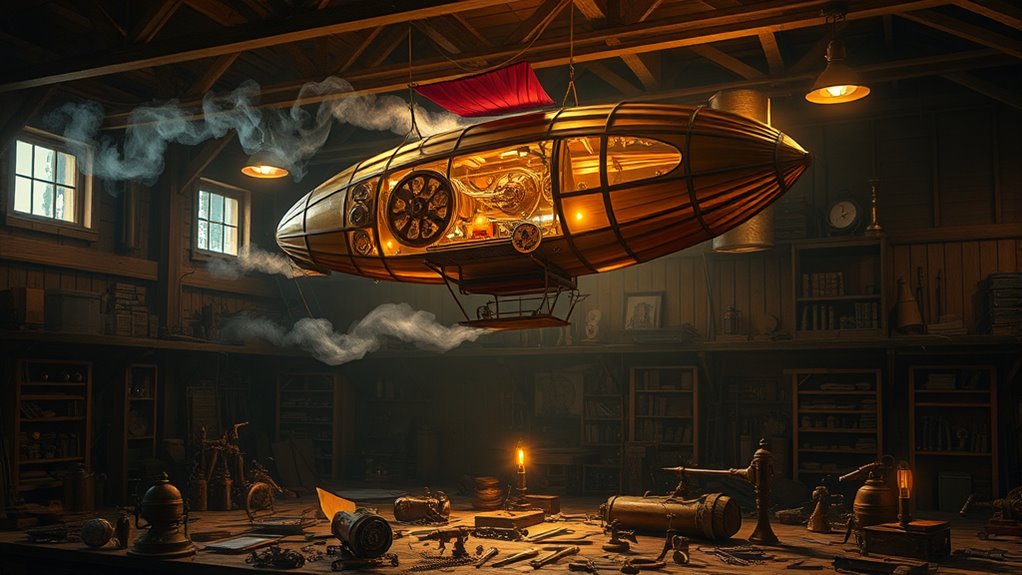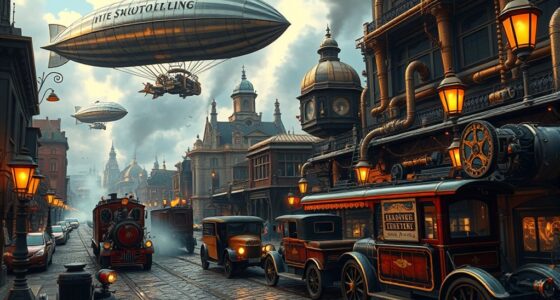The physics of steampunk blends Victorian innovation with quantum principles, challenging traditional concepts of gravity and logic. You'll see how electric lighting and steam engines come together with quantum mechanics to create fantastical gadgets. Imagine devices that leverage entanglement for instant communication or engines that achieve incredible efficiency. This unique fusion not only sparks your imagination but also inspires real scientific exploration. Keep exploring to uncover even more fascinating ideas from this captivating genre.
Key Takeaways
- Steampunk physics blends Victorian innovations like steam power and electricity with imaginative concepts to challenge conventional scientific logic.
- Quantum entanglement enables hypothetical instant communication, suggesting technologies that could defy traditional mechanics and perceptions of time.
- The fusion of thermodynamics and quantum concepts allows for theoretical engines achieving efficiency beyond classical limits, embodying steampunk aesthetics.
- Challenges in scaling quantum systems highlight the intricate balance of maintaining coherence and managing environmental noise, paralleling steampunk's complex machinery.
- Engaging narratives in steampunk can make complex scientific principles accessible, inspiring curiosity about the interplay between physics and imaginative technology.
The Victorian Foundations of Steampunk Physics
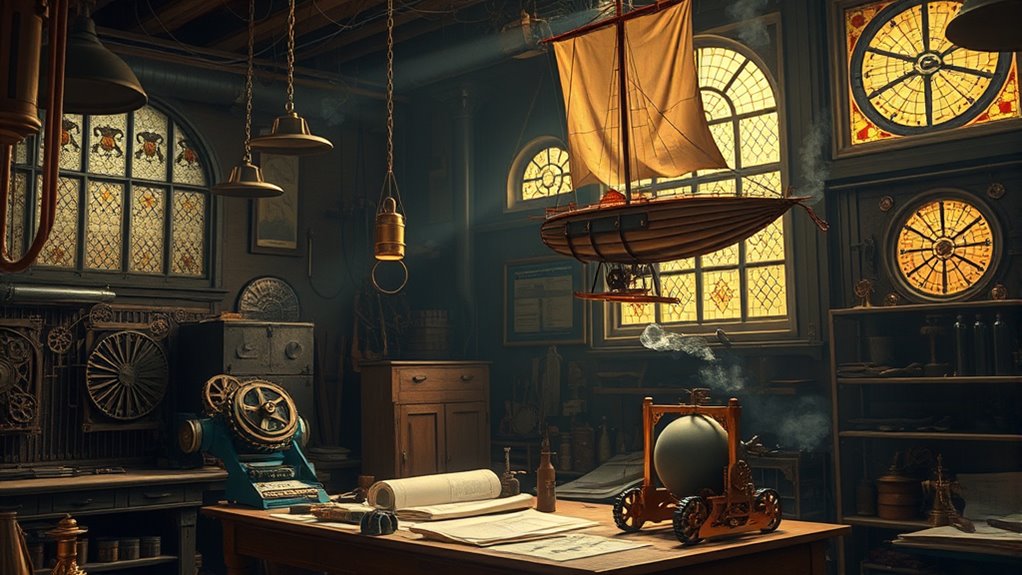
The Victorian era sparked a wave of innovations that laid the groundwork for what we now recognize as steampunk physics. Electric lighting and the internal combustion engine transformed daily life, inspiring imaginative designs that blend the fantastical with the mechanical. The discovery of electricity enabled the creation of intricate machines that powered not only homes but also the adventurous spirit of the era.
Communication breakthroughs, like the telephone and telegraph, connected people in ways that fueled creative storytelling, inviting you to envision worlds where technology and adventure intertwine.
The telephone and telegraph sparked connections that ignited imaginative tales of intertwining technology and adventure.
Medical advancements, including the stethoscope and X-rays, pushed the boundaries of human understanding, enhancing the allure of scientific exploration.
As you dive into this world, you'll see how Victorian ingenuity serves as a foundation for the steampunk aesthetic, where Victorian-style inventions meet whimsical interpretations of science and technology, inviting you to explore the limitless possibilities of imagination.
Merging Thermodynamics and Quantum Concepts

As you delve into the fascinating realm where thermodynamics meets quantum mechanics, you'll discover a rich tapestry of concepts that challenge traditional understanding. Quantum thermodynamics explores how thermodynamic principles apply to small systems, like particles and molecular machinery. Unlike classical thermodynamics, measuring incompatible quantities in quantum systems affects outcomes, revealing a unique interplay. This interaction can even lead to decreased entropy production, shifting our perception of time's arrow. The relationship between quantum mechanics and statistical mechanics is essential for understanding these phenomena. Autonomous quantum machines, such as quantum refrigerators, showcase practical applications, cooling qubits without constant oversight.
The Role of Entanglement in Steampunk Technology
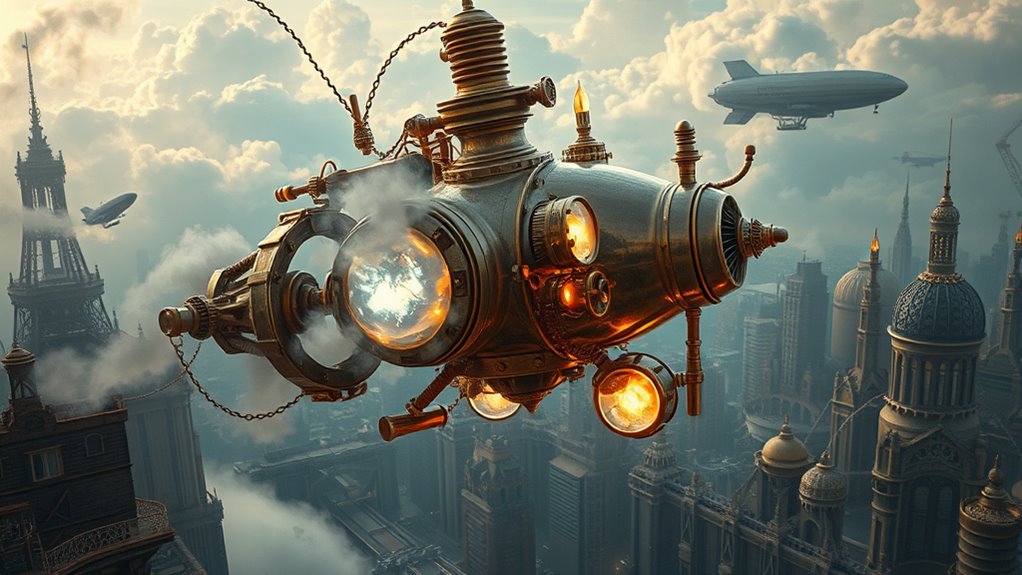
Incorporating entanglement into steampunk technology opens up intriguing possibilities for innovation and connectivity.
Imagine harnessing quantum entanglement to create devices that allow instant communication across vast distances, revolutionizing how characters interact in your steampunk narrative. You could develop quantum power sources, providing energy in ways that defy traditional mechanics and enhance your fantastical machines. This technology could enable real-time FTL communications, allowing characters to send messages instantaneously regardless of distance.
Harness quantum entanglement for instant communication and revolutionary power sources in your steampunk adventures.
Steampunk storytelling could explore themes of non-locality, pushing the boundaries of space and time while offering a fresh perspective on interconnectedness.
Additionally, envision data processors that leverage entangled particles, surpassing classical computing and enabling advanced functionalities.
Challenges of Scaling Quantum Systems
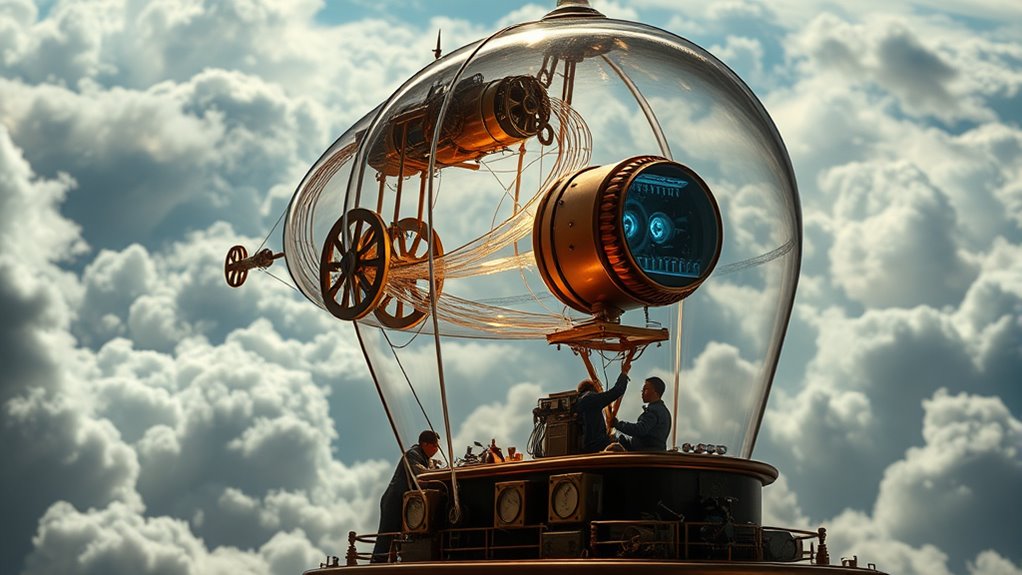
While scaling quantum systems offers exciting potential, it also presents significant challenges that must be addressed. You'll find that maintaining qubit coherence is crucial, as these delicate states are highly sensitive to environmental noise and decoherence caused by electromagnetic interference. As you increase qubit counts, the complexity of cooling systems for superconducting qubits escalates too. Additionally, error rates also rise, making quantum operations less reliable. Furthermore, implementing effective error correction is daunting; surface codes require thousands of qubits for just one logical qubit. Finally, wiring bottlenecks limit scalability, and while photonic interconnects and 3D integration show promise, they're still experimental. Overcoming these hurdles is essential for realizing the potential of large-scale quantum computing.
The Interplay of Information and Energy
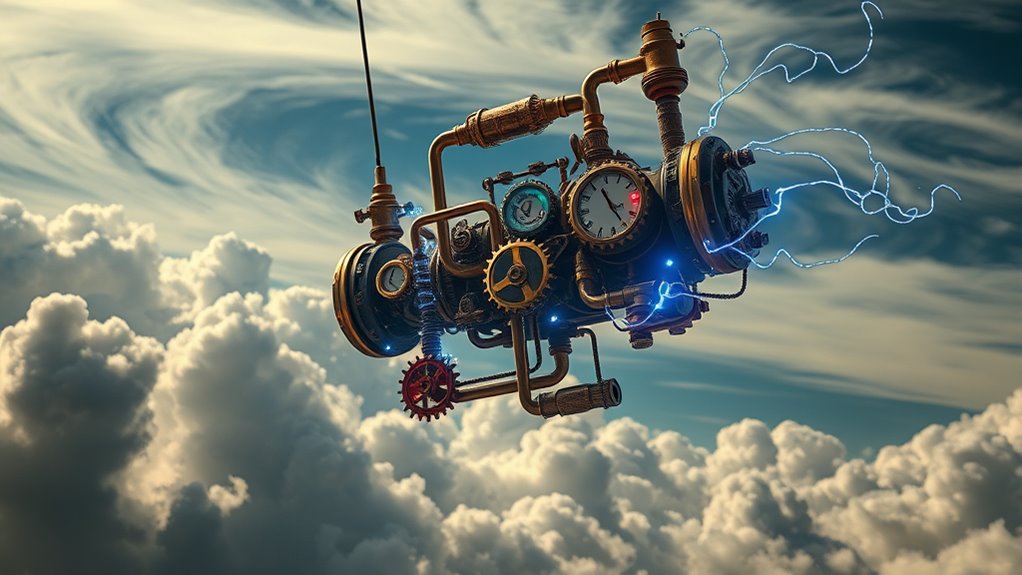
The interplay of information and energy in quantum systems reveals fascinating insights that challenge our understanding of thermodynamics. You'll find that concepts like quantum steampunk creatively merge Victorian energy principles with modern quantum mechanics. Research shows that quantum systems can enhance energy efficiency, potentially revolutionizing technology. As you explore quantum engines, you'll see how they blend quantum mechanics with classical thermodynamics, pushing efficiency beyond traditional limits. Furthermore, the relationship between time and energy in noisy quantum systems significantly impacts precision in tasks like metrology. This intricate dance between information and energy shapes the performance of quantum systems, highlighting their potential for innovation in energy conversion and harnessing new efficiencies in our ever-evolving technological landscape. Notably, optimal partitioning of time can enhance estimation precision in these systems, demonstrating the intricate connections between energy management and temporal dynamics.
Steampunk as a Catalyst for Scientific Innovation
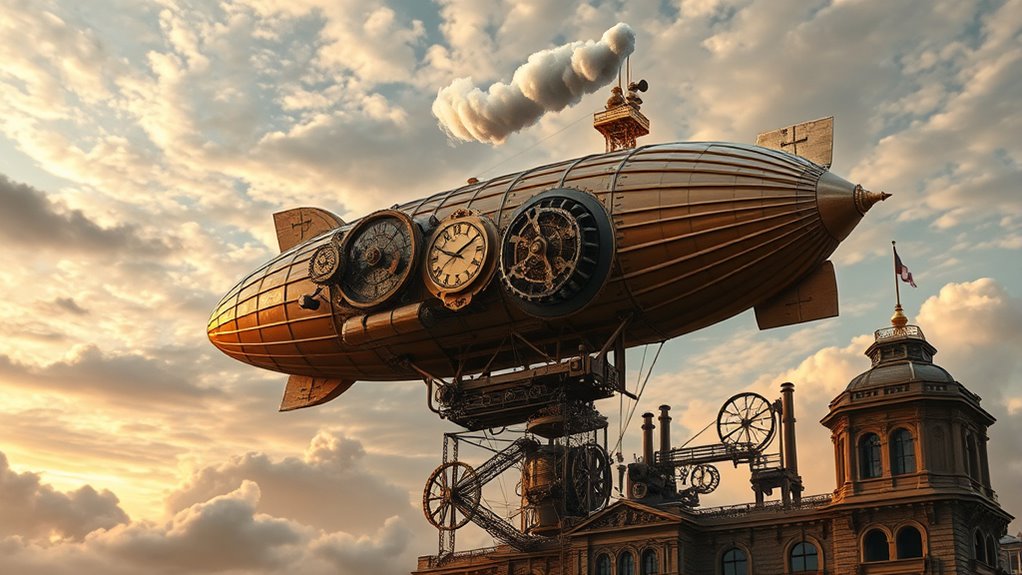
Steampunk serves as a vibrant catalyst for scientific innovation, blending imaginative aesthetics with practical technology.
You'll find that this genre encourages you to rethink historical developments alongside modern advancements, creating a space where creativity flourishes. Utilitarianism's greatest happiness principle illustrates how the blend of creativity and practicality can lead to innovations that benefit society as a whole.
By exploring steam power and its historical impact, you can draw inspiration from the past to imagine new possibilities.
Steampunk's mechanical automatons and advanced medical practices reflect a speculative creativity that challenges the constraints of history. The fusion of steampunk fiction with nonfiction allows for an engaging exploration of complex scientific concepts.
This intersection of fiction and reality pushes you to engage critically with technology, fostering a community of makers and inventors.
Ultimately, steampunk inspires you to envision innovative solutions and encourages interdisciplinary collaboration, making complex concepts more accessible and igniting a passion for STEM fields.
Future Implications of Quantum Steampunk Mechanics

Imagining the future of technology through the lens of quantum mechanics opens exciting possibilities in the realm of quantum steampunk mechanics.
You could witness a transformation in energy systems where quantum engines achieve unprecedented efficiency, merging Victorian aesthetics with modern physics. Entropy quantifies the effectiveness of information processing, which will be crucial as these engines develop.
With advancements in quantum computing, you might find fault-tolerant systems that manage heat effectively, revolutionizing information processing and encryption.
Imagine vehicles powered by quantum-enhanced energy sources, offering sustainable alternatives.
As researchers explore atomic and molecular behaviors, they'll tackle fundamental questions about time and entropy, reshaping our understanding of thermodynamics.
This interdisciplinary collaboration could spark breakthroughs that not only advance technology but also enrich education, making complex quantum concepts accessible through engaging steampunk narratives.
Frequently Asked Questions
How Does Steampunk Influence Modern Technology Today?
Steampunk influences modern technology by inspiring innovation in mechanical engineering and alternative energy sources.
When you explore its DIY culture, you'll find hands-on approaches that encourage grassroots tinkering. The retro-futuristic designs and aesthetics challenge you to rethink product functionality while evoking nostalgia for tangible tech.
As you engage with steampunk communities, you'll discover collaborative opportunities that blend art, science, and engineering, pushing the boundaries of what technology can achieve today.
What Are the Aesthetic Elements of Steampunk Design?
Steampunk design features a fascinating mix of vintage and industrial aesthetics.
You'll notice rich colors like burgundy and dark green, combined with warm tones such as creams and browns.
The materials often include polished wood, leather, and brass, showcasing intricate filigree and mechanical elements like gears and cogs.
Vintage lighting, such as oil lamps, adds an authentic touch, while rustic furniture and distressed finishes create a charming, nostalgic atmosphere in any steampunk-inspired space.
Are There Real-Life Applications of Steampunk Principles?
Absolutely, there are real-life applications of steampunk principles! You can see them in medical simulators that mimic human anatomy for training, or in DIY projects where you create personalized devices.
Steampunk also inspires community engagement, promoting collaboration and hands-on learning. Additionally, it encourages a human-centric approach to technology, emphasizing creativity and craftsmanship over mass production.
How Do Artists Incorporate Steampunk Themes in Their Work?
When you look at steampunk art, you see a clash of the past and future; Victorian elegance meets futuristic imagination.
Artists incorporate gears and steam engines, creating scenes that blend nostalgia with innovation. They use metallic materials and rich color schemes to bring their visions to life.
What Role Does Storytelling Play in Steampunk Culture?
Storytelling in Steampunk culture immerses you in a world where history meets imagination.
You explore alternative realities filled with steam-powered wonders and Victorian aesthetics. Through rich narratives, you encounter themes of innovation and rebellion, challenging societal norms.
The characters inspire you, often as inventors or adventurers, pushing boundaries and sparking curiosity. By engaging with these stories, you gain insight into technological consequences and societal change, making the experience both entertaining and thought-provoking.
Conclusion
In conclusion, steampunk physics invites you to defy convention and explore a world where Victorian imagination fuels scientific innovation. By merging thermodynamics with quantum concepts, you're not just dreaming; you're rewriting the laws of reality. The challenges of scaling these ideas may seem daunting, but they're also the spark that ignites creativity and wonder. So, dive into this fantastical realm—you might just discover that the impossible is within reach, waiting for you to seize it!
